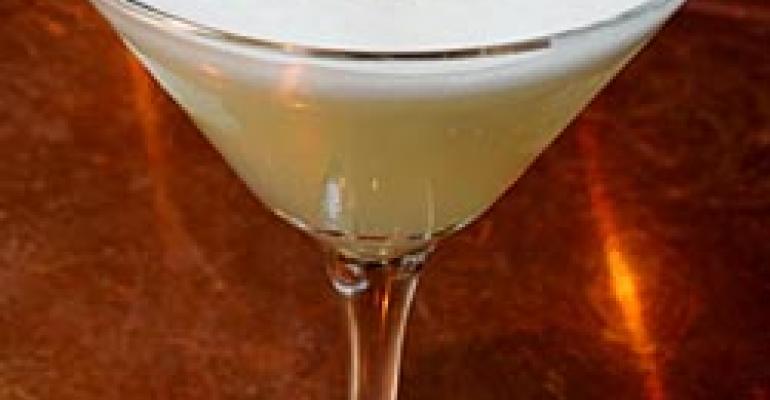Striving to offer up the next Latin cocktail sensation — or to at least give spirits savants a new plaything — some restaurant and bar operators are touting the Pisco Sour, a tangy and sweet libation with more than passing resemblance to current hits like the Margarita, Caipirinha and Mojito.
The cocktail, which both Peru and Chile claim to have invented, is made with pisco, a clear, unaged grape brandy that is shaken vigorously with ice, lemon or lime juice, simple syrup or sugar and egg white. The shaking lends a characteristic silken crown of foam over which a few drops of aromatic bitters are sprinkled for good measure.
"It's a really delicious cocktail, and very popular," said Paulius Nasvytis, owner of the Velvet Tango Room, a swank nightspot in Cleveland. "It's refreshing and citrus-y, similar to a Margarita or any of the members of the sour family." Nasvytis' version is made with BarSol pisco from Peru and priced at $14. He noted that although Peruvians normally serve the drink in a small tumbler, he shows it off in a martini glass.
At Eastern Standard Kitchen & Drinks in Boston, bar manager Jackson Cannon likens pisco to grappa, the spirit Italians make from grape skins. Both are characteristically rough-edged on the palate. "But that's what makes mixing it fun," said Cannon. "It retains some character after it has been introduced to citrus and sweetening. That's why a lot of us find mixing with vodka boring, because that's all you have." His sour is priced at $10.
When it comes to frothing cocktails, Cannon is old school, cracking fresh eggs and separating the whites. "It's probably safer than scrambled eggs, with the citrus and alcohol," he said. The less confident may choose pasteurized whites. Cannon also explained the bitters: "Eggs have great texture and flavor, but the aroma can be a little off-putting. Using bitters as the garnish completely reverses that effect."
Despite its rough associations, a lot of handiwork goes into the manufacture of the better piscos. By law in Peru, and only in Peru, pisco must be distilled in a pot still — not an industrial-type continuous still — to bottling proof. That means it may not be diluted with water before bottling, unlike most spirits, allowing it to undergo a more precise distillation.
By Peruvian tradition, pisco puro is the sturdy no-frills version favored for Pisco Sours. It's made from grapes with little aroma, like quebranta. There's also pisco aromatico, made from muscat-like grapes. It has a big bouquet and goes down easier, but it may fade when mixed. Many prefer it straight. A third type, pisco acholado, is a happy medium, blended from aromatic and nonaromatic grapes.
Although still little known in the United States, the Pisco Sour may see its fortunes rise because of the growing appreciation some Americans have for Peruvian cuisine. Andina, a restaurant in Portland, Ore., is one of several dining spots gaining notoriety for interpreting the Peruvian table. The cuisine is a mixture of indigenous influences dating back to pre-Incan days, leavened with Hispanic and Asian immigrant traditions.
Discovering Peruvian cuisine "is like stumbling over Motown when no one was listening to it," said Andina bartender Greg Hoitsma. "Wow, what's this doing down there? It's a fully mature culinary style that hasn't been exported yet."
Among the hallmarks of novoandina or "New Andean" restaurants are signature renditions of traditional items like ceviche, or fresh, uncooked fish marinated in citrus juices and seasonings, and papas a la huancaina, cold boiled potatoes topped with spicy cheese sauce, black olives and hard cooked eggs, as well as forward-looking creations.
For a frothier Pisco Sour, Hoitsma advises shaking the ingredients initially without ice, because they foam better warm. For garnish, in addition to Angostura Bitters, he squeezes half a key lime onto the foam and then drops it into the glass. "It gives a certain rusticness," he said.
For a simple cocktail, the Pisco Sour has inspired much contention. One of the controversies is whether it needs lime or lemon juice. "We go back and forth over which is better," said Hoitsma, noting that Peruvian citrus doesn't have an exact counterpart in the States. "We generally stay with lime, because that sounds more authentic to our Peruvian customers."
And then there's the rivalry. Don't even think of serving Chilean pisco to a Peruvian, or Peruvian pisco to a Chilean. The neighbors each claim the spirit as a birthright and deny the other's claim. "If we whipped out a bottle of Chilean pisco here…." Hoitsma says.
He doesn't bother to finish the sentence.




